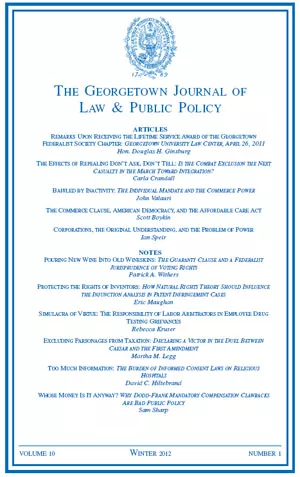- | Government Spending Government Spending
- | Journal Articles Journal Articles
- |
The BRAC Commission as a Model for Federal Spending Reform
Originally published in The Georgetown Journal of Law & Public Policy
The success of BRAC shows how to overcome public choice dynamics at a time of crisis. These lessons apply today, but they must be understood correctly. While creating a small commission or task force to tackle a problem has many advantages, it is just one aspect of what made BRAC succeed. A spending commission modeled on BRAC should be focused, independent, composed of disinterested citizens given clear criteria for their decisions, and be structured in a way that allows its recommendations to be operative unless Congress rejects them. This prescription is the only way that a spending commission has a chance to actually result in spending cuts.

Federal spending, debt, and deficits are at all-time highs,1 and there is pressure on both political parties to cut spending.2 President Obama recognized this when he said,
In these challenging times, when we are facing both rising deficits and a sinking economy, budget reform is not an option. It is a necessity. We cannot sustain a system that bleeds billions of taxpayer dollars on programs that have outlived their usefulness, or exist solely because of the power of a politician, lobbyist, or interest group.We simply cannot afford it.3
On several occasions he has pledged to conduct a line-by-line review of the federal budget, cutting wasteful and inefficient spending.4 The President, however, does not control the purse strings. Spending reform must happen in Congress, and this is easier said than done.5
As President Obama’s words suggest, in many cases spending programs exist for political reasons. Almost every federal program has a constituency that lobbies hard to keep it alive, whether it is an efficient program or not. Members of Congress are beholden to these interests, so they champion the programs and horse-trade to ensure they remain funded.
At the same time, the cost of each federal spending program is spread so widely among all taxpayers that it is barely noticeable. The public and members of Congress worry about an out-of-control budget and agree that spending must be reined in, but there is no agreement on which particular programs to cut or reform. This is the classic public choice dynamic of concentrated benefits and dispersed costs.6
For example, Congress continues to approve billions of dollars in ethanol subsidies each year despite a wide consensus that these programs are inefficient, do little to improve “energy security,” and are likely bad for the environment.7 The reason is that while the cost of the subsidies is spread among all taxpayers, the benefits accrue to a small group that can more easily organize itself to lobby Congress. Given this dynamic, how can we ever hope to “go through our federal budget—page by page, line by line—eliminating those programs we don’t need,” 8 as the President has promised?
Today’s situation is similar to what we experienced at the end of the Cold War. Record deficits cried out for spending cuts, and an indisputable glut of military bases was the obvious target.9 By definition each base was in a congressional district so that they each had a literal constituency and a designated champion in Congress. While the public at large could agree that a large reduction in bases was necessary, citizens could also agree that their hometown base should be exempt. And so it was that between 1977, when Congress began to take a more prominent role in base realignment, and 1988, when reforms were finally implemented, not one major base was closed.10
Through a combination of genius and good luck, in 1988 Congress created the Base Realignment and Closure (BRAC) Commission to address the impasse. 11 The Commission was composed of independent experts who were to select which bases should be closed or realigned based largely on military need.12 Once made, their recommendations would become binding unless Congress passed a joint resolution of disapproval.13 In the first iteration of BRAC, the Commission recommended eleven major bases to be closed or severely realigned.14
The BRAC scheme successfully broke the political impasse that prevented base closures. As a result, many today are proposing schemes based on the BRAC model to help cut inefficient and wasteful government spending.15 The key components of these new reform proposals are a congressional commission and expedited legislative procedures. These proposals, however, resemble BRAC only superficially.
The BRAC commissions of the late 80s and early 90s were successful because of their peculiar structure—not simply because they were independent commissions, and not simply because of their all-or-nothing approach to base closures. In this Article we first look at the history of BRAC and the roots of its success. We then contrast today’s commission proposals to the successful BRAC process, and show how these proposals lack some of the key ingredients that made BRAC successful. Finally, we suggest how a new federal spending commission could be more closely modeled on BRAC.

